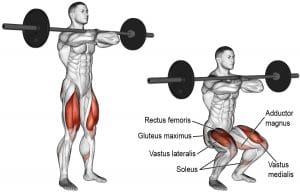There is a good reason that old-school bodybuilders used to call squats “The King of Exercises.” If you want to get strong, build bigger legs, get powerful for sports, or lose weight and tone up, squats can help.
Squats work your entire lower body, but the benefits don’t stop there. A set of heavy squats also work your lower back, upper back, core, and even your arms. Very few exercises involve as many muscle groups at the same time, with deadlifts and the Olympic lifts (clean and press, and snatch) being the obvious exceptions.
It’s also thought that squats increase the production of growth hormone and testosterone. These two hormones are critical for muscle repair and growth (1). However, heavy deadlifts also have the same effect.
Squats are such a beneficial lift that entire workout plans have been written around them. One such example is the famous 20 rep squat routine, an old-school workout program that’s all but guaranteed to increase the weight and muscle mass of anyone prepared to try it.
It’s clear that if you want to get big and strong, squats should be part of your workout plan. But, which squat is best for adding muscle mass to your thighs?
While the answer to this question is up for debate, the answer could be the front squat.
In this guide, we’re going to show you how to do front squats properly, why front squats are such a useful exercise, and reveal what you can do to become an even better front squatter, so your workouts are more productive.
How to Front Squat
Before we get into all the reasons you should start doing front squats, let’s make sure you know how to do this exercise properly. After all, to enjoy all the benefits that front squats offer, you need to do them right!
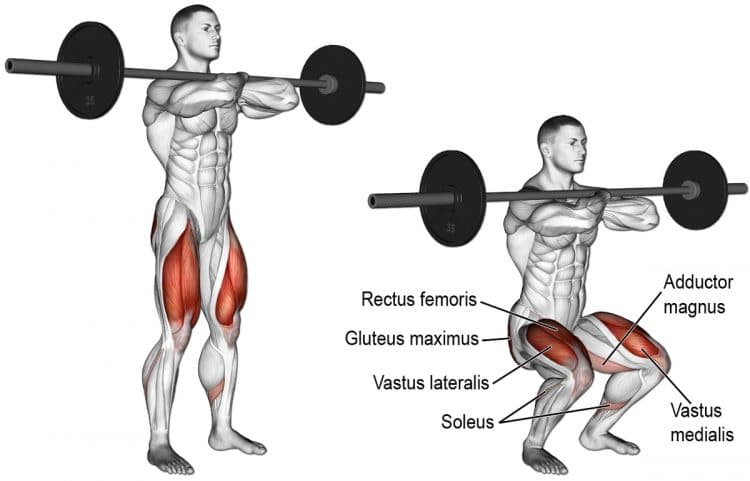
- Put a barbell in your squat rack at about shoulder-height. You should need to bend your knees slightly to unrack the bar and not stand on tiptoes.
- Walk forward and put your anterior (front) deltoids against the bar. Grip the bar with your hands just wider than shoulder-width apart. Depending on your flexibility, this may mean you can only get your fingertips to the bar, and cannot fully wrap your hands around it. That’s ok; the bar should sit in the creases of your shoulders and remain in place even if you aren’t gripping it with your hands.
- Push your elbows forward, and under the bar so your upper arms are parallel to the floor. The bar should rest against your neck, but it should not press on your throat.
- Brace your core and pull your shoulders down and back. Unrack the bar and take 1-2 steps back.
- Set your feet between hip and shoulder-width apart. Most people use a narrower stance for front squats compared to back squats.
- Brace again, inhale, and bend your knees and hips at the same time. Descend as far as you can while keeping your torso upright, your elbows up, and your knees in line with your toes. Do not allow your knees to drop out or fall in. Look straight ahead and not down.
- Without bouncing out of the bottom, drive your feet into the floor and stand back up. Force your elbows upward as you ascend to stop the bar rolling off your shoulders.
- Rerack the bar and rest or, if you are doing multiple reps, reset your core and repeat.
Front Squats Advantages and Benefits
When it comes to squats, most people automatically gravitate toward the back-squat variation. This makes a lot of sense because it’s easier and more comfortable to rest the bar on the back of your body. There are high bar back squats, where the bar rests on the upper traps, and low bar back squats, where the bar rests lower across the shoulders.
Read more about the difference between high bar vs. low bar squats in this article.
All types of squats work the muscles of the lower body, specifically:
- Quadriceps – the muscles on the front of your thighs and responsible for knee extension.
- Hamstrings – located on the back of your thighs and responsible for knee flexion and hip extension.
- Gluteus maximus – the muscles on the back of your hips responsible for hip extension.
- Erector spinae – the muscles of the lower back, and responsible for spine extension or, in the case of squats, keeping your spine rigid.
- Core – the collective term for the muscles of the midsection responsible for maintaining lumbar spine stability and intra-abdominal pressure to support your spine.
- Abductors and adductors – the muscles on the inside and outside of the thighs, respectively. These muscles help stabilize your hips and knees, preventing your thighs from falling in or out while you squat.
With front squats, you hold the bar across the front of your shoulders. This forces you to keep your torso more upright, producing a range of useful advantages and benefits, especially when compared to back squats.
Those advantages and benefits are:
Increased potential range of motion
The squat depth is affected by several factors, including joint health, flexibility, and leg length but, all things being equal, most lifters can squat deeper when they do front squats.
Deeper squats mean more work for the quadriceps as they’ll be forced to move through a larger range of motion. To clarify this advantage, think of back squats as a more hip-dominant movement, whereas front squats are a more knee-dominant movement. More knee dominance means increased quadriceps recruitment.
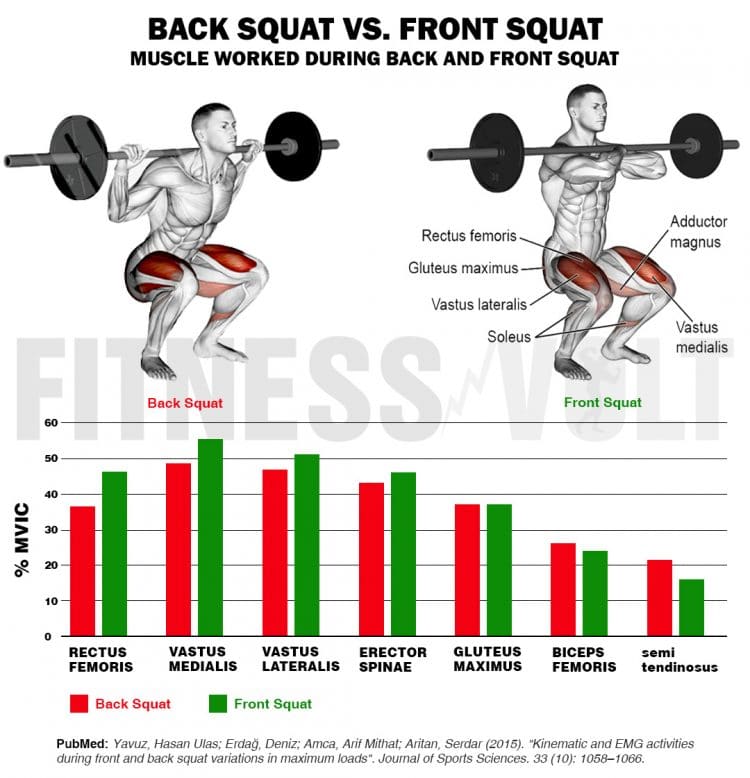
Study: Yavuz, Hasan Ulas; Erdağ, Deniz; Amca, Arif Mithat; Aritan, Serdar (2015). “Kinematic and EMG activities during front and back squat variations in maximum loads”. Journal of Sports Sciences. 33 (10): 1058–1066. (2)
That’s not to say the hamstrings and glutes are inactive during front squats. It’s just that the quads are working a little harder, and the glutes and hamstrings are slightly less involved. When hypertrophy is the name of the game, such small differences can be very advantageous.
A stronger core and upper back
With the barbell held on the front of your shoulders, you’re going to have to work harder to keep your torso upright. Your upper back is going to have to work especially hard. It’s no coincidence that many Olympic lifters, who do more front squats than back squats, often have such impressive upper backs.
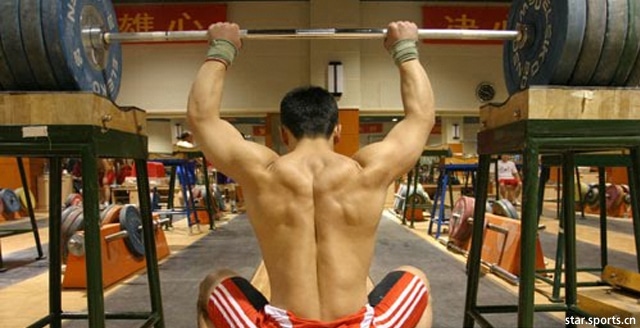

A stronger, more muscular upper back will not only add a lot to your physique, but it will also increase your deadlift, overhead press, and even your bench press performance.
Better for your posture
Posture refers to the alignment of your joints, and posture can be good or bad. Good posture means your joints are correctly aligned, which puts minimal stress on things like connective tissue and muscles. Bad posture puts a lot more stress on your joints. Long periods spent sitting can cause your upper back to become rounded as your muscles lose the fight against gravity. This can lead to hyperkyphosis, causing upper back and neck pain.
Front squats force you to keep your torso upright, strengthening the muscles responsible for better posture, and can also help increase thoracic spine (T-spine) mobility.
Less stress on your spine
The further forward you lean, the more pressure there is on your spine. Put a weight on your back, and that stress quickly increases. By allowing for a more upright position, front squats put much less strain on your spine. There is still a compressive force, but less shearing force, and it’s the latter that is most likely to cause back injuries.
Easier on your shoulders
Back squats, especially the low bar variation, can be hard on your shoulders. You’ll need to pull your hands back a long way to get a good grip on the bar. If you have shoulder problems, and especially if you use a narrow grip, getting your hands into position can be challenging, if not painful.
That’s why a lot of powerlifters use such a wide grip when they squat. All that heavy bench pressing can really extract a toll on your shoulder joints.
While front squats do require good upper body mobility to do them properly, they aren’t as hard on your shoulder joints. Front squats are a good exercise choice for lifters with banged-up shoulders.
You’re forced to squat with good technique
When you are doing back squats, your technique can deteriorate significantly, and you’ll still be able to keep cranking out the reps. Even if you lean forward too far, the bar will remain in place.
With front squats, if you fail to maintain that all-important upright posture or lower your elbows, you’ll probably drop the bar. It’s much harder to do front squats with improper technique. Good technique makes any exercise safer AND more effective.
Easier to dump the bar if you fail
Back squats should always be done in a power rack. That way, if you get stuck at the bottom of a rep, you won’t get stapled to the floor by a heavy weight. Needless to say, getting stuck under a heavy weight at the bottom of a squat could cause serious injury.
With front squats, you can dump the bar forward and off your shoulders if you can’t complete a rep. While this SHOULD only be done in emergencies, it’s nice to know you have an escape strategy if you fail during a set of front squats.
It also means you can use squat stands instead of a power rack. Squat stands are lighter, cheaper, and take up less space than power racks, making them useful for home and garage gyms.
Easier on your knees
Studies have revealed that front squats are easier on your knee joints than back squats, despite the increased range of motion (3). That’s great news if your knees are beaten up from years of heavy training.
Similar hypertrophy benefits with less weight
Most people cannot front squat as much weight as they can back squat. The difference is often 25% or more. The increased range of motion and biomechanical differences mean that front squats are more demanding and less efficient.
This makes front squats as beneficial as back squats for building muscle, despite using lighter weights. The increased difficulty makes up for the reduction in load and ensures your quads will still grow even with less weight on the bar.
Front Squat Faults and How to Fix Them
To enjoy all of the benefits that front squats have to offer, you must perform them correctly. If you don’t, you could end up wasting a whole lot of time and energy and even get injured. Here are the most common front squat faults and how to fix them.
You can’t get into the front rack position
For a lot of people, the front rack position is the hardest part of front squats. It takes good mobility and flexibility to create a solid shelf for the bar to rest on. If you don’t rack the bar correctly, your arms are much more likely to drop, and so too is the barbell. Having big biceps can also make front squats difficult.
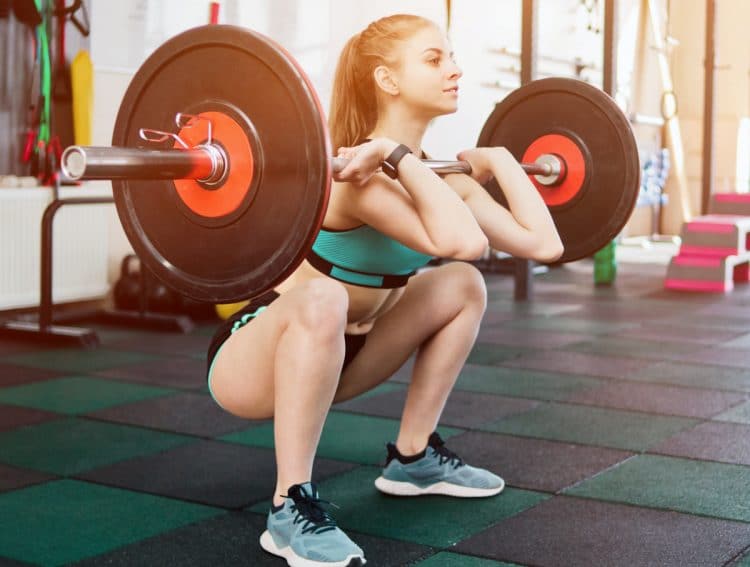
Big arms and poor mobility are why some bodybuilders use a cross arm grip for front squats instead of the more traditional clean grip.
You can get around the problem of limited flexibility by using lifting straps. Attach them to the bar and then grab the loose ends.
Better still, work on your T-spine mobility and upper body flexibility to make getting into the front rack position easier.
To do this, set up a barbell in a squat rack as though you were going to do front squats. Next, grab the bar and practice getting into the front rack position, or as close as you can manage, without lifting the barbell. Push your elbows forward and focus on pointing your elbows slightly upward to get a deep stretch in your arms and shoulders. Hold this position for 30-60 seconds. Increase your range of motion as you feel your muscles begin to relax.
You can also do this exercise with one arm at a time, using your free arm for assistance.
Tight forearms can also make front racking difficult. If you feel an intense stretch in your forearms during front squats or cannot get more than your fingertips to the bar, this could be your issue.
Stretch your forearms by kneeling down and pressing the heels of your hands flat to the floor. Shift your weight back to intensify the stretch. This exercise can be uncomfortable if you have very tight forearms. But, if you persevere, it will get easier and will have a noticeable impact on your front squats.
You can’t help rounding your upper back
A rounded upper back is a common front squat fault. It can be caused by poor T-spine mobility, as well as a lack of upper body strength. It may also be an indicator that you are trying to lift more weight than you should and can even be caused by looking down instead of looking straight ahead or slightly up.
If reducing the weight doesn’t help, and you aren’t looking down at your feet, try the following solutions:
T-spine mobilization – kneel down and place your elbows on a box or bench. Holding a dowel, bend your arms and lower your chest down toward the floor. Ask a partner to gently push your upper arms together. Relax and allow your body weight to gently extend your thoracic spine.
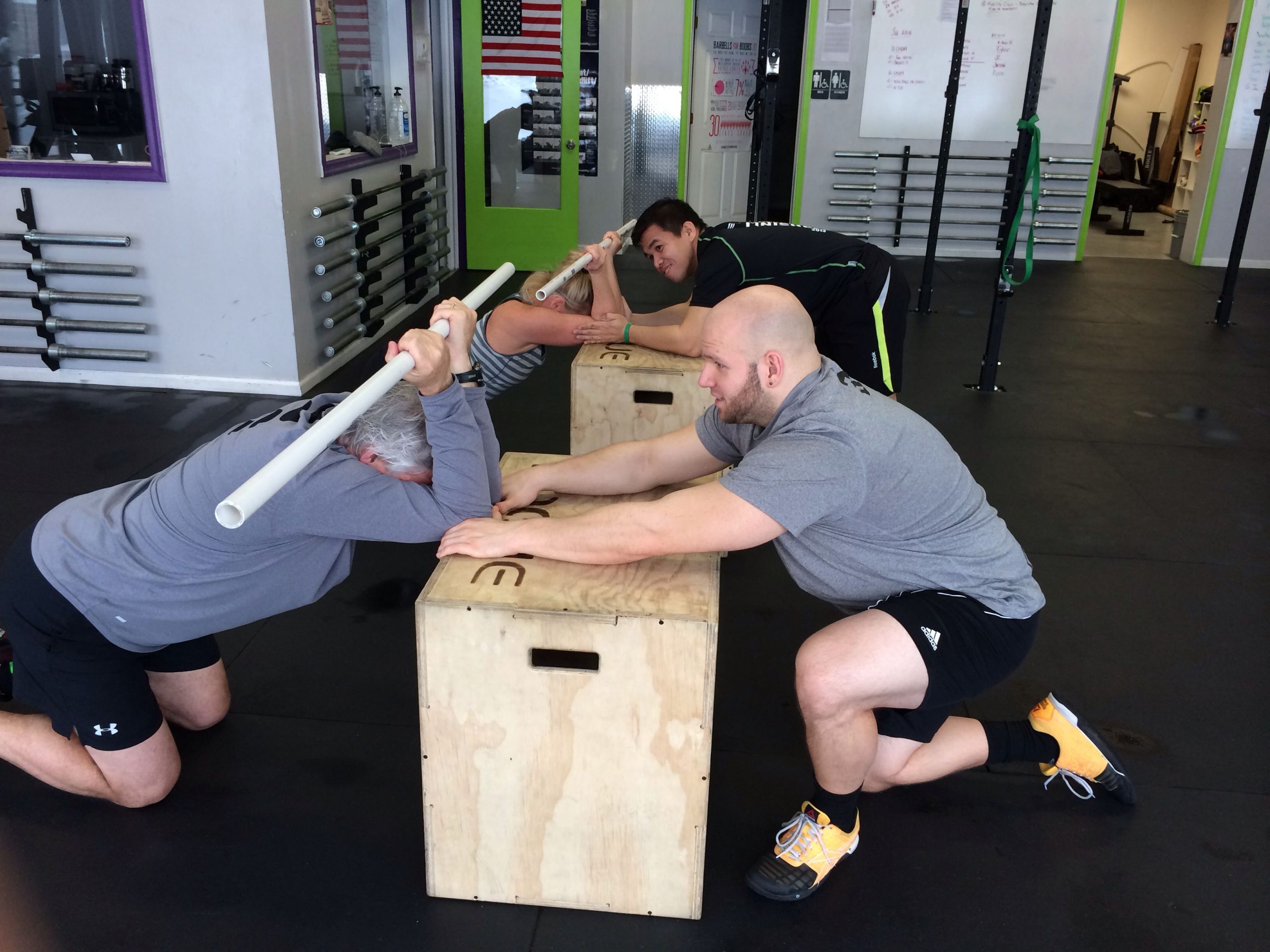

Reverse incline shoulder presses – this unusual-looking exercise works your posterior deltoids, middle traps and rhomboids, and your upper back extensors. Go light; this is a challenging exercise!
Set an exercise bench to about 45-degrees and, with a dumbbell in each hand, sit on it with your chest against the back support, i.e., the wrong way around. Raise the dumbbells up to your shoulders.
Press the weights straight up so that they are in line with your body. Do NOT press them horizontally. You should feel an intense contraction around your upper back and between your shoulder blades. Lower the weights back to your shoulders and repeat.
For even better results, perform the T-spine mobilization exercise and reverse incline shoulder presses as a superset. Mobilizing your T-spine beforehand will make the pressing exercise both easier and more effective.
Your hips rise faster than the bar
This is a common back squat fault that can also happen during front squats, although it is rarer. The most likely cause is that your quads are stronger than your glutes and hamstrings or that your core is weak. You may also be losing core tension and intra-abdominal pressure as you ascend.
Fix these problems by:
- Doing more deadlifts and Romanian deadlifts to strengthen your posterior chain.
- Start doing some weighted core exercises, such as shovel lifts, barbell rollouts, or cable abs exercises to increase core strength.
- Practice bracing against heavy resistance, e.g., single-arm farmer’s walks.
- Exhale gradually as you ascend, and do not blow out all your air too soon. This will help you maintain intra-abdominal pressure.
You get stuck at the bottom of your rep
This is quite normal when you are lifting heavy weights and is probably a sign that your quads are failing. Increase quads strength with some quad-specific exercises such as:
You can’t squat below parallel
While knee health can determine squat depth, if your knees are in good shape, flexibility is probably the main factor stopping you from descending below parallel. Most people find they can go deeper on front squats than back squats, so if you aren’t hitting parallel or below, you probably need to work on your flexibility.
One of the best exercises for improving flexibility for squatting is called the third-world squat, also known as the Slavic squat. This exercise mimics how many people “sit” when they don’t have a chair.


To do it, stand with your feet shoulder to hip-width apart. Push your knees out, your hips back, and squat down as deep as you can. The aim is to touch your calves with your hamstrings. Sit in this position for 30-60 seconds and then stand up. Increase depth and duration to gradually improve your flexibility.
If balance proves difficult, tie a belt to a waist-high anchor and hold on to it. Wearing weightlifting shoes with raised heels can also help balance and stability, and many lifters find that they can squat deeper wearing this type of footwear.
The final thing to address that may affect front squat depth is ankle mobility. A deep front squat means your knees must be able to travel forward over your toes, and that is affected by ankle mobility. If you find you can squat deeper when you raise your heels or that your heels lift up when you try to squat deep, this could be your problem.
Increase your ankle flexibility by stretching your calves. Stand in a staggered stance with the toes of either foot touching the bottom of a wall. Push your knee forward until it’s against the wall. Move your foot back a little and repeat. Continue until you find the limit of your flexibility. Stay in this position for 30-60 seconds. Ease out of the stretch and repeat on the other leg.
Programming for Front Squat Hypertrophy
Front squats increase quads activation, making them better for hypertrophy. Just doing front squats instead of back squats should lead to more quads growth. But you’ll get even better hypertrophy if you train specifically for that goal.
Apply the following information to your front squat workouts to produce the best possible results:
Focus on the 6-12 rep range – while you can train outside of this rep range now and then, the more time you spend in the 6 to 12-reps range, the more likely you are to trigger hypertrophy. Rest for 60-90 seconds between sets.
Train close to failure – you’ll trigger more hypertrophy if you front squat to failure or very close to it. Push yourself until you feel you are unable to perform another rep in good form. Do your squats in a power cage for safety, or make sure you know how to dump the bar in case you get stuck at the bottom of a rep.
Use appropriate weights – for hypertrophy, you should train with loads around 67-85% of your one-repetition maximum, or 1RM for short. You can estimate your 1RM using an online calculator, or even test it for real by doing a series of progressively heavier single reps until you hit your max.
Alternatively, if the weight you are using takes you to failure within 6-12 reps, you are probably using the right weight, even if you don’t know your 1RM or what percentage of it you are lifting.
Use blood flow restriction training – blood flow restriction training, or BFR for short, is a proven way to make almost any leg or arm exercise more effective. It’s ideal for using with front squats.
BFR involves wrapping an elastic bandage above the muscle you want to target. This reduces blood flow, which makes your chosen exercise more challenging and more productive. It also means you don’t have to use such heavy weights.
Try a training system – training systems are recognized methods that increase exercise intensity. As a general rule, the harder an exercise is, the more effective it will be. Good front squat hypertrophy training systems include:
- Supersets – do a set of leg extensions immediately before or after a set of front squats
- Matrix – also known as 21s
- Paused reps – stop at the bottom of each rep for 2-3 seconds
- German Volume Training – 10 sets of ten reps with 60 seconds of rest
Check out this article to discover The 13 Best Methods For Increasing Training Intensity.
Train your quads twice a week – if your quad development is lacking, try hitting them twice a week with two different workouts. Separate your workouts by 2-3 days to allow for adequate recovery. For example:
| Workout one – Monday | Workout two – Thursday | ||
| Exercise | Sets and reps | Exercise | Sets and reps |
| Front squats | 4 x 6 | Back squats | 4 x 6 |
| Leg press | 3 x 8 | Hack squats | 3 x 8 |
| Leg extensions | 3 x 10 | Single-leg extensions | 3 x 10 |
| Step-ups | 3 x 12 | Lunges | 3 x 12 |
Front Squat Variations and Alternatives
The barbell front squat is an amazing exercise, but that doesn’t mean it’s the only exercise you can use to make your legs bigger and stronger. In fact, it’s just one of many movements you can use to train your lower body. The following variations and alternatives are ideal for keeping your workouts fresh and interesting.
1. Goblet Squats
The goblet squat is a front squat but, instead of using a barbell, you use a single kettlebell or dumbbell. This front squat variation requires much less upper body and T-spine mobility, so it’s a more accessible exercise.
Also, with just a dumbbell or kettlebell required, it’s ideal for home use. On the downside, you won’t be able to use as much weight, so this variation is not as good for building strength.
2. Two kettlebell/dumbbell front squat
No barbell or squat racks around, but still want to do front squats? Don’t worry – you can do this excellent exercise using nothing more than a pair of dumbbells or kettlebells.


How to do it:
- Clean and rack the weights on the front of your shoulders and then step out into your preferred squat stance.
- Brace your abs and pull your shoulders down and back.
- Once you are in position, squat down as deep as your mobility allows while keeping your torso upright.
- Stand back up and repeat.
3. Front box squats
Box squats have several benefits and uses:
- They teach you to squat to a consistent depth by providing you with a target to aim for.
- They break the eccentric/concentric contraction cycle so that each rep starts from a dead stop, making the exercise harder.
- They force you to descend with more control, reinforcing good squatting mechanics and increasing time under tension for greater hypertrophy.
Boxes are typically used for back squats, but they can be used for front squats too.
How to do it:
- Set up for front squats as usual but place a knee-high bench or box behind you.
- Squat down to the box and sit on it without relaxing. Pause for 1-2 seconds.
- Drive up and out of the squat and stand up.
- Do not descend too fast as hitting the box at speed could jar your back.
- The lower the box, the harder this exercise becomes.
4. Bottom up front squats
With this variation, which is also called the Anderson squat, you start each rep from the bottom instead of the top.
How to do it:
- Place your barbell in a squat rack set to about hip-height.
- Drop down under the bar and adopt your usual front squat position.
- Once you are ready and braced, stand up explosively and then squat back down again.
- Allow the bar to settle on the pins, reset your core, and then repeat.
- This exercise can also be done with bands or chains to increase tension at lockout.
5. Hands-free front squat
The hardest part of front squats, at least while you are learning to do them correctly, is keeping your upper arms parallel to the floor. If your arms start to fall, the bar will roll off your shoulders, and you could even drop it.
This exercise is designed to reinforce correct bar placement and strengthen your upper back for better front squats. It’s a challenging exercise so start with a light weight, and even just an empty bar or a broomstick.
How to do it:
- Place your barbell in a squat rack at about shoulder level.
- Rest the bar across your shoulders as usual but then, instead of gripping the bar with your hands, extend your arms out in front of you. Your arms should be parallel to the floor.
- Squat as usual while taking extra care to keep your arms up for the duration of your set.
6. Front rack Bulgarian squats
For this front squat variation, you hold the bar in a front rack position while you work one leg at a time doing Bulgarian split squats. This exercise is good for mobility and flexibility, as well as balance. It’s also an excellent way to overload one leg at a time and identify and fix left to right strength imbalances.
How to do it:
- Stand with your back to a knee-high bench. Rack and hold your barbell across the front of your shoulders. Make sure your upper arms are parallel to the floor.
- Bend one leg and place your foot on the bench behind you.
- Bend your legs and lower your rearmost knee down to within an inch of the floor. Keep your torso upright.
- Stand back up and repeat.
- Rest a moment, swap legs, and repeat.
7. Front rack lunges
Lunges are typically done with dumbbells or a barbell resting on the upper back. That doesn’t mean you can’t do them in the front rack position. This forces you to keep your torso more upright, increasing quad and glute activation in the process.
You can do forward, walking, or backward front rack lunges as preferred, and you can also do deficit lunges, where you step onto or off a 4 to 6-inch platform. This increases the range of motion and makes your chosen lunge more challenging.
8. Front rack step-ups
Step-ups, like lunges and Bulgarian split squats, are unilateral exercises, which means they work one leg at a time. This makes them especially useful for sports such as running and cycling and for anyone who wants to make sure that both legs are worked equally.
The front rack position forces you to keep your torso more upright, which increases quad activation while taking stress off your lower back.
How to do it:
- Rack and hold a barbell across the front of your shoulders. Alternatively, you can use two dumbbells or kettlebells.
- Stand in front of a knee-high step or bench. Make sure it’s strong and stable enough to support your weight.
- Lift and bend one leg, placing your foot flat on the platform. Drive your foot down and step up, trying to use your trailing leg as little as possible.
- Step back down and repeat.
- You can use an alternating leg action or, if you prefer, do all your reps on one side before swapping.
9. Thrusters
Thrusters combine front squats with overhead presses. This full-body exercise can be done with heavy weights to build strength or light to moderate weights to improve muscular endurance and general fitness.
How to do it:
- Rack and hold a barbell across the front of your shoulders. Alternatively, use dumbbells or kettlebells. Step out and into your usual front squat stance. Brace your core and pull your shoulders down and back.
- Squat down as deeply as your mobility allows.
- Drive your feet into the floor and stand up explosively.
- Use this momentum to help you push the weight up and overhead.
- Lower the weight back to your shoulders and then repeat.
10. Front rack farmer’s walk
A lot of lifters find the front rack position challenging. It requires good upper body flexibility, T-spine mobility, and supple wrists too. The more time you spend in the front rack position, the easier it will become.
Front rack farmer’s walk provides a great way to practice holding a barbell across the front of your shoulders without having to worry about doing squats. It’s also a good core, upper back, and cardio exercise.
How to do it:
- Rack and hold a barbell across the front of your shoulders. Either clean the bar from the floor or take it from a squat rack.
- Point your elbows forward and keep your upper arms parallel to the floor. Brace your abs and pull your shoulders down and back.
- Maintaining this position, go for a walk around your training area.
- Continue until you are unable to maintain the front rack position.
- Set the bar down, rest a moment, and repeat.
Assistance Exercises to Boost Your Front Squat Performance
If you are a beginner and are still learning or getting used to front squats, you should focus on becoming more proficient with this exercise. Fix your faults and do front squats a couple of times a week to reap their benefits.
But, if you are an intermediate or advanced lifter who wants to become a better front squatter, there are several exercises you can do that could boost your performance. Use the following assistance exercises to fix any weak links and build the muscles you need to front squats harder and heavier.
Zercher squats
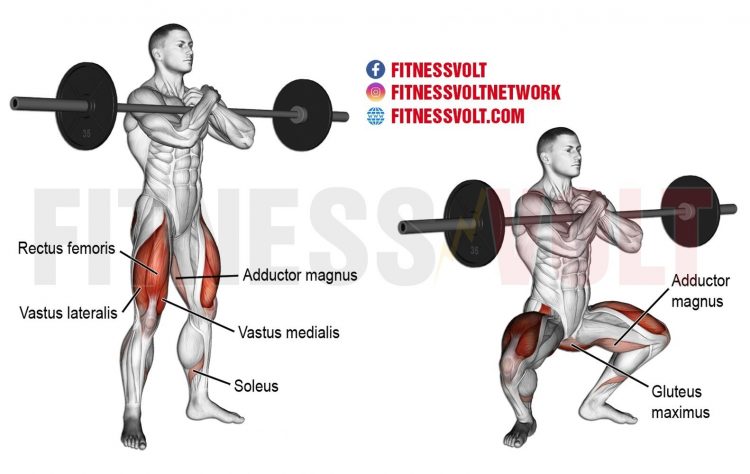

Zercher squats work most of the same muscles used in front squats. However, the lower bar placement increases upper back stress, and for a lot of lifters, a weak upper back is a limiting factor.
You may also find you can squat deeper with Zerchers than front squats, increasing quad activation. Finally, Zercher squats are hard on your biceps, which, while not especially relevant for front squats, is still a cool benefit!
Overhead squats
If poor flexibility is your front squat nemesis, overhead squats can help. Do them with a light bar or even just a broomstick to increase upper and lower body flexibility. As your overhead squats improve, front squats will seem much easier. Read more about overhead squats here.
1 ½ rep front squats
This front squat assistance exercise really hammers your quads with some extra time under tension. If you keep getting stuck at the bottom of your reps, strip some weight off the bar and do this exercise for a few weeks. When you come back to regular front squats, your quads should no longer be the weak link.
To do this assistance exercise, descend as usual and then come halfway up from the bottom of your squat. Descend again and then stand all the way up. That’s one rep. And yes, that awesome thigh pump you get at the end of your set is perfectly normal.
Hip belt squats
Hip belt squats use the same muscles and movement as front squats, but without using your upper body. This leaves you free to focus on working your legs as hard as you can. With more muscular legs, you should find front squats much easier.
How to do it:
- Put on a dip belt and load it with an appropriate weight. You may need to use a single loading pin so the weights or chains don’t rub painfully against your inner thighs.
- Stand with your feet on two sturdy platforms about shoulder-width apart.
- Bend your knees and squat down as deep as you can, mimicking your usual front squat range of motion.
- Stand back up and repeat.
Weighted back extensions
Front squats aren’t as taxing for your back as back squats, but your back muscles still play an important part in keeping your torso upright. Make sure your back muscles are up to the task by doing weighted back extensions.
- Adjust the pad on the back-extension machine, so it’s about hip-height. Climb onto the machine and place your feet on the footrests with your knees slightly bent. Hold a weight plate or dumbbell close to your chest. Pull your shoulders down and back.
- Hinging from your hips, lean as far forward as you can without excessively rounding your lower back.
- Lift your upper body back up until your knees, hips, and shoulders form a straight line. Do not hyperextend your spine as doing so won’t make the exercise any more effective and could increase your risk of injury.
- Use a moderate to heavy weight and do low to medium reps to build back, glute, and hamstring strength.
Wrapping Up
If you want bigger legs, you’ve got to squat. But, if you want bigger quads, front squats are probably the best squat variation to use. Front squats are more knee dominant than back squats and also take your quads through a larger range of motion. These differences mean that, for quadriceps hypertrophy, front squats are tough to beat.
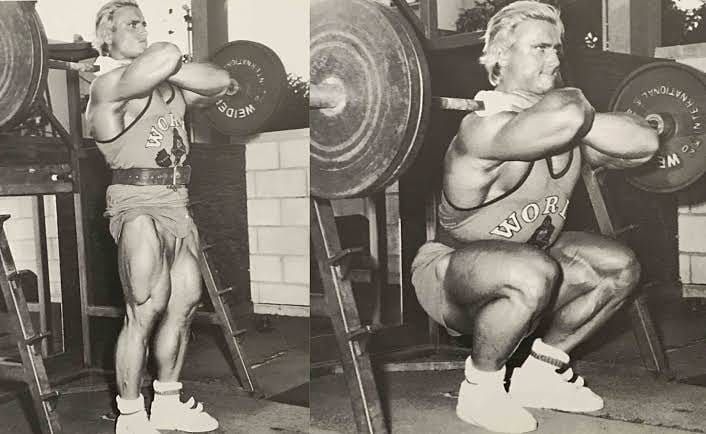
But, on the downside, front squats are also a challenging exercise to learn and master. They require a strong upper back, excellent thoracic spine mobility, and good upper body flexibility. They’re also hard on your ego because most lifters cannot front squat as much as they back squat.
This means that a lot of exercisers who try front squats do them once, but not twice. They’re a humbling exercise!
But, if you persevere, front squats could be the key to unlocking your best quads ever. There is a reason that some of the bodybuilders with the best quads were also avid fans of front squats. They really work.
Build legs you can be proud of with this challenging, super-effective exercise.
References:
1. PubMed: Wilk, Michal; Petr, Miroslav; Krzysztofik, Michal; Zajac, Adam; Stastny, Petr (2018-10). Endocrine response to high intensity barbell squats performed with constant movement tempo and variable training volume. Neuro Endocrinology Letters. 39 (4): 342–348.
2. PubMed: Yavuz, Hasan Ulas; Erdağ, Deniz; Amca, Arif Mithat; Aritan, Serdar (2015). Kinematic and EMG activities during front and back squat variations in maximum loads. Journal of Sports Sciences. 33 (10): 1058–1066.
3. PubMed: Gullett, Jonathan C.; Tillman, Mark D.; Gutierrez, Gregory M.; Chow, John W. (2009-01). A biomechanical comparison of back and front squats in healthy trained individuals. Journal of Strength and Conditioning Research. 23 (1): 284–292.

